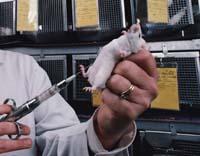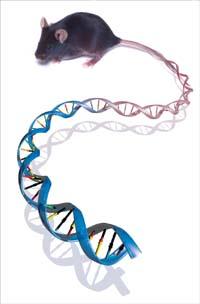The mouse to the measure of man

Nguyen and Xu are experts in genetics and molecular biology and have published a paper on mouse influence in medicine. According to them, the mouse has influenced the human population since the beginning of civilization and has been taken in many ways: from being the greatest enemy of the peasants to being a companion animal. Now the human being uses it for his benefit, being human biology and the animal model most important for the understanding and research of diseases.
The physiology of the mouse and of the person and the structure and organization of the tissues are similar. It also suffers many diseases that suffer from human beings, hereditary and caused by various genes. In fact, 99% of the genome is equal in both species and its number is similar. In addition, it has unique characteristics to be a good laboratory animal: it reproduces quickly and has many offspring, does not need care or special places to grow...
The entire mouse genome was decoded in 2002 and compared to the genes of man and mouse, researchers have collected clues to understand the function of many of these genes. At first it was thought that the function of the genes was quite simple and genes were sought for specific diseases. Simply put, they associated the guilt of a disease to the bad practice of a gene, whose aim was to find it.
Today, scientists know that the relationship between diseases and genes is very complex. The identification of genes is not enough; to understand their function, it is essential to take into account the elements that regulate their activity, and all this is the subject of study by the researchers.
Selection and transformation

In 2002 the entire mouse genome was decoded. (Photo: NHGRI).
Either way, the genetics of mice began long ago. Nguyen and Xu mention that the Chinese made a genetic selection to obtain their favorite varieties: albinas, leather of one color or another, mice dancers... The latter present an error in the inner ear that makes them move as if they were dancing. This error is hereditary.
The most widely used mouse variety in laboratories is the heir of those developed in China. C. C. C. C. It was founded in 1921 by the American genetic Little. He started from mice from the same family and crossed 20 generations obtaining a genetically uniform variety. This genetic equality is very important to be able to perform all experiments in the same conditions and to be able to compare the results.
In addition, it is a quiet variety, not aggressive, so it has become the most common laboratory animal. It has been very useful to study physiology and human biology and to find the keys to many diseases. For example, thanks to them, researchers have identified and analyzed many genes related to different types of cancer, which, because of their taste for alcohol and other drugs, also use them to investigate addictions.
But in addition to genetic selection, researchers use genetic transformation to adapt mice to their needs. Somehow, they get mice to the measure of the human being. The Physiology or Medicine Novel of last year was delivered to researchers who obtained genetically modified mice. Specifically, they developed the technique of creating mice in which certain genes had been inactivated.
These mice are called knockout and in 1989 the first study was published with this type of mice. Since then they have created many types of mouse of this type, according to what they have wanted to investigate, from the development of the embryo to the most serious diseases, to the study of the effect of gene therapy. To do this they inactivate the gene they want to study and see how it has influenced.
Another way to genetically transform mice is the incorporation of human genes into their genome. This type of mice is called transgenic and the first was achieved in 1982, introducing a rat gene to a mouse. They have carried out and are carrying out numerous research with different objectives: to analyze the function and activity of certain genes, to carry out experiments of gene therapy, etc.
However, researchers still have a lot to do. One of the objectives is to completely complete the genetic map of the mouse, know not only where it is and what each gene is for, but how its activity is controlled. In addition, researchers are working on the development of new methods of genetic transformation of mice.
For example, Nguyen and Xu investigate with the aftermath. The transposones are fragments of DNA that can be moved from one place to another of the genome and that the researchers want to take advantage to inactivate certain genes of the mouse and deduce the function of the gene in view of the influence that the inactivation produces in the mouse. That is, they want to find another way to reach the same goal, easier and faster than so far.
Nguyen and Xu have no doubt: the relationship between man and mouse has solid bases and a long and prosperous future. However, there are still mice that give it disgust...
Published in Gara
Buletina
Bidali zure helbide elektronikoa eta jaso asteroko buletina zure sarrera-ontzian











